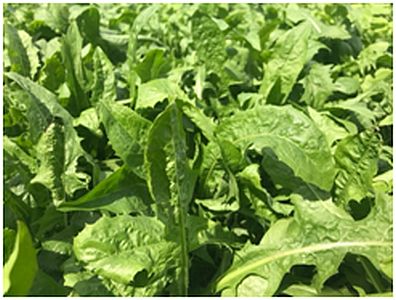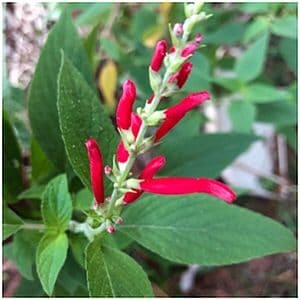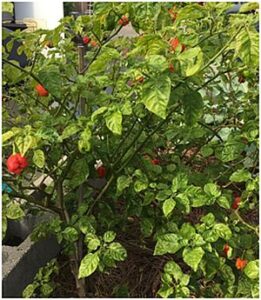(Image above: The attractive flowers of chamomile can be used for decoration in the home. Photo by Heather Kirk-Ballard/LSU AgCenter)
Herbs and Spices
Herbs and spices both come from plants. (Salt is neither a spice nor an herb. It is a mineral.) Herbs and spices are used primarily for adding flavor and aroma to food. Both are best used fresh but can be saved by drying. While there are similarities, there also are subtle differences between herbs and spices.
Herbs are the leaves of herbaceous (non-woody) plants. They are used for savory purposes in cooking, and some have medicinal value. Herbs often are used in larger amounts than spices. Herbs originated from temperate climates such as Italy, France, and England. Herb also is a word used to define any herbaceous plant that dies down at the end of the growing season and may not refer to its culinary value at all.
(Images above: [left] Pineapple sage – Salvia elegans – Photo K. Blackburn; [center] Peppers, Chinese species Capsicum annuum at Federal City Garden in Algiers – Photo K. Blackburn; [right] Basil that’s allowed to flower is attractive to pollinators, such as bees — Photo by Heather Kirk-Ballard/LSU AgCenter)
Herbs grow well in containers on patios in partial to full sun as well as in landscapes and raised beds. Herbs can be grown year-round in Louisiana. They are categorized by the season in which they grow. Cool-season ones grow best in cooler weather, and warm-season ones do best in late spring to early autumn. Herbs are further categorized into annuals and perennials. Annuals will complete their lifecycle in one year, and perennials will live for several years.
You can grow herbs from seeds, or transplants. Transplants are easy. Seeds, however, are much less expensive, although they take more time and planning. If you are starting with seeds, you can begin planting them up to one month before you plan to set them out in a garden or planter. Begin seeds in trays in a hot house, a greenhouse or windowsill that gets a great deal of light.

(Image above: Garlic with plastic mulch to control weeds. Photo by Kiki Fontenot/LSU AgCenter)
Herbs suggested by AgCenter state vegetable specialist Kiki Fontenot:
Annual herbs for spring and summer are also known as warm-season herbs and are best planted in the garden after the last frost date. Those dates are typically March 15 in south Louisiana and after April 1 in north Louisiana. Warm-season herbs that generally grow well in Louisiana include basil, mint, lemon verbena, rosemary, sage, thyme, lavender, catnip and bay laurel.
Annual herbs for fall and winter are cool-season herbs that should be planted in the garden between September and February. Most cool-season herbs can tolerate normal winter freezes in Louisiana. Later in the cool season, in March or early April, plant larger transplants for harvesting in late May to early June.
Cool-season herbs that generally perform well in Louisiana include parsley, cilantro, chamomile, dill, oregano, borage, chives, garlic, celery, chicory, fennel, arugula and chervil.
Perennial herbs that do well in Louisiana include anise, hyssop, bay laurel, catmint and all other mints, lemon verbena, lemon balm, rosemary, Mexican tarragon, burnet, garlic, chives, oregano, pineapple sage and rue.
Although most perennial herbs can be planted throughout the year, they perform best when planted in the fall using transplants available at local nurseries. This allows them to become well established during the less-stressful cool season.
Thyme, sage, catnip, scented geraniums and lavender are perennial herbs that require excellent drainage to survive the summer. They may be more successful when grown in containers and placed in a location that gets some afternoon shade during the summer. These herbs can be short-lived and are susceptible to root and stem rots in the hot, wet conditions of the late summer season.
Several perennial herbs that have difficulty surviving our summers are grown here as cool-season annuals and include French tarragon, feverfew and chamomile.
Spices are obtained from roots, flowers, fruits, seeds or bark. Spices are native to warm tropical climates and can be woody or herbaceous plants. Spices often are more potent and stronger flavored than herbs; as a result they typically are used in smaller amounts. Some spices are used not only to add taste, but also as a preservative.
Some plants are both herbs and spices. The leaves of Coriandrum sativum are the source of cilantro (herb) while coriander (spice) is from the plant’s seeds. Dill is another example. The seeds are a spice while dill weed is an herb derived from the plant’s stems and leaves.

(Image above: Chicory is a popular herb in the South. (Photo by Kiki Fontenot/LSU AgCenter)
Examples of Spices:
• Cinnamon – bark of the cinnamon tree
• Ginger – root
• Cloves – flower bud
• Saffron – stigma (female reproductive part) of saffron crocus
• Nutmeg – seed
• Vanilla – undeveloped fruit of an orchid
• Cumin – seed
To keep your herbs producing and healthy, do not overharvest the foliage. Take no more than one third of the total foliage at any one time. The flowers of herbs may also be used as a garnish or to flavor dishes as well as to attract pollinators. Many also may be used as cut flowers. Herbs that have started flowering and setting seed can be harvested to replant for the next season.
Harvest and dry or freeze herbs for later use before the crops wear out at the end of the growing season. Gather, rinse and tie a bunch together and hang them upside down in cool, dry places indoors with good air circulation for dried herbs. Store them in air-tight containers protected from light in your pantry or kitchen cabinets. Freeze herbs after cutting by rinsing, drying and then finely chopping them. Store them in freezer bags laid thin in half-inch layers in the freezer. Label with the herb name and date.
*Herbs information comprised of Information from KiKi Fontenot, LSU Horticulture from Article written by Heather Kirk-Ballard, LSU Consumer Horticulturist. Spice information from article Herbs vs Spices by Foy Spicer (Horticulture Dept) from Horticulture and Home Pest news, Iowa State University Extension and outreach.

By Karen Blackburn




